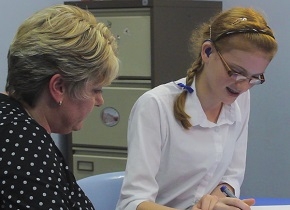
Request a full Catch Up® information brochure and details of our free information webinars
Find out more
Lots of my Year 7s are working at just below the level needed to fully participate in the Key Stage 3 curriculum. Is Catch Up® the answer?
Many pupils start Key Stage 3 with literacy and numeracy levels below those required to fully participate in the Key Stage 3 curriculum. In government-speak, these pupils are not ‘secondary-ready’. Typically, these pupils are reasonable decoders of text but may lack the inferential comprehension skills expected of readers in Key Stage 3 English classes. They may be quite confident at addition and subtraction but less secure in the skills of decimals and fractions. These pupils are often about 6 months behind age-related expectations. In terms of Catch Up® levels, they are likely to be functioning at level 12.
The Catch Up® interventions are primarily intended for pupils who are struggling with literacy and/or numeracy. These pupils may be as much as three years or more behind age-related expectations.
So, are the Catch Up® interventions suitable for pupils who may need a literacy or numeracy boost rather than needing a systematic revision of the core skills?
Yes … and No!
Generally, we don’t recommend that pupils start Catch Up® at level 11 or 12. But the answer does depend on whether the pupil is having difficulties with literacy or numeracy.
If the pupil is performing at Catch Up® Literacy level 12 (National Curriculum Level 3a in old-speak!) then the most likely gaps in their literacy/English skills are:
Catch Up® is the working name of The Caxton Trust, a not-for-profit charity registered in England and Wales (1072425) and Scotland (SC047557) as well as a company limited by guarantee (03476510). Catch Up is a registered trademark.
The Catch Up® Web site use "cookies" to help you personalise your online experience. A cookie is a text file that is placed on your hard disk by a Web page server. Cookies cannot be used to run programs or deliver viruses to your computer. Cookies are uniquely assigned to you, and can only be read by a web server in the domain that issued the cookie to you.
Click on the different category headings below to find out more. You can change your default settings very easily. To turn cookies on, click the button to the right. To turn cookies off, click the buttons to the left. Please read our cookie policy to find out more.
Performance monitoring cookies: Google Analytics cookies (_ga,_gid) - these can last up to 2 years.
Strictly necessary cookies used by the site content management system: PHPSESSID (used to record your logged in session) and allow_cookies (used to record that the user has consented to cookies) - these are either temporary (session) cookies or expire after no more than 30 minutes and are used to provide functionality as you navigate around the site and allow you to access secure areas.